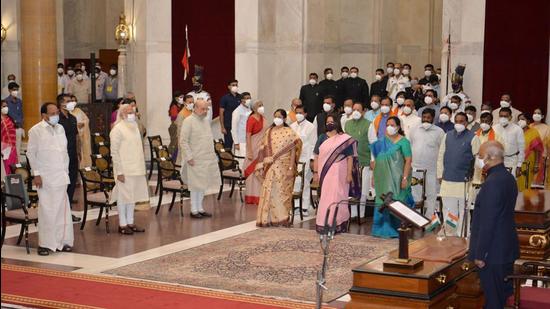The method in Modi’s rupture
Politics has mattered. But Prime Minister Narendra Modi’s choices also reflect his quest for a governance reset
Cabinet reshuffles are largely driven by political considerations – the desire to reward allies; the need to accommodate lateral entrants into a party that is in power; and the importance of focusing on a region headed for polls and sustaining a party’s core political appeal. The sweeping reshuffle effected by Prime Minister (PM) Narendra Modi in his Cabinet, which saw 36 new faces being inducted into the council and seven junior ministers being promoted, does all this. For instance, the Bharatiya Janata Party (BJP) has succeeded in many states by consolidating the traditionally fragmented Hindu vote across other backward classes (OBCs), and by focusing on the scheduled caste and scheduled tribe (SC/ST) vote. Of the 77 ministers in the council (excluding the PM), 27 are from OBCs and another 20 from SCs/STs.

But it also does more.
It does more because the reshuffle has seen 12 ministers, of which six were of Cabinet rank, being dropped, including some, it is widely believed, for reasons related to performance. Among them are two ministers who were pretty much in charge of the government’s outreach to media, and their exit may well have to do with the overall unhappiness in top government circles over the emerging narrative on India.
It does more because it has consciously sought to lower the average age of the council. After the changes, 14 members of the council, including six of Cabinet rank, are younger than 50. The decision to induct or promote some of these young leaders also seems to have been done with an eye on the future, especially in states such as Gujarat and Telangana. And it does more because at least some of the choices made are unconventional and based on leadership and administrative abilities, educational background, or expertise.
The second Modi government just completed two years in office in late-May. But many of its plans, including an ambitious one to make India a $5-trillion economy, have run aground due to Covid-19; and the perception is that it has not managed the pandemic well. It needed to take corrective action, and also be seen to be taking corrective action, and the change in the health and labour ministries is seen as just that (it’s probably as much of an acknowledgement that can be expected from this government that things could have been managed better on both fronts). It needed to have, and been seen as having, a team that could turn things around, and the induction of new faces, including some surprising choices, is perhaps aimed at this.
It isn’t easy to drop seven senior ministers.
Doing so runs the risk of attracting criticism for mistakes any government, including the current one, would be loath to admit to; yet, Mr Modi seems to have decided that it was necessary to do this, to correct the course as much to signal that this is being done, and that he has the ability to deal with whatever criticism may arise.
Perhaps the two most interesting aspects of the reshuffle aren’t the choice of ministers inducted or those dropped but the approach that Modi has adopted to ministries — clubbing related ones together under the same minister (pharma, for instance, comes under the health minister for the first time; education and skill development are together under one minister; as are commerce and textiles, where the future is export-driven). There was talk of this in 2014 too, but back then, it was about shrinking and clubbing entire departments, not easy to accomplish. This time, the effort has been to put the same minister in charge of ministries that could benefit from working together – a far better approach, and easier to implement perhaps. As a result, 32 ministers (of which 30 are of Cabinet rank and two are ministers of state with independent charge) will manage all ministries, supported by 35 ministers of state, of whom at least some have been appointed for purely political reasons.
This is arguably the most sweeping reshuffle in a council of ministers in independent India. Indeed, there have been comparisons with the Kamraj plan, named after the Congress leader and Tamil Nadu chief minister who might well be the best PM India never had; he suggested in 1963 that senior ministers resign (or be removed) and work for the party. The radical reconstitution of PM Modi’s team comes at a time when there are significant challenges on several fronts and on this team’s success depends not just the success of the government and the BJP, but also that of the country.



